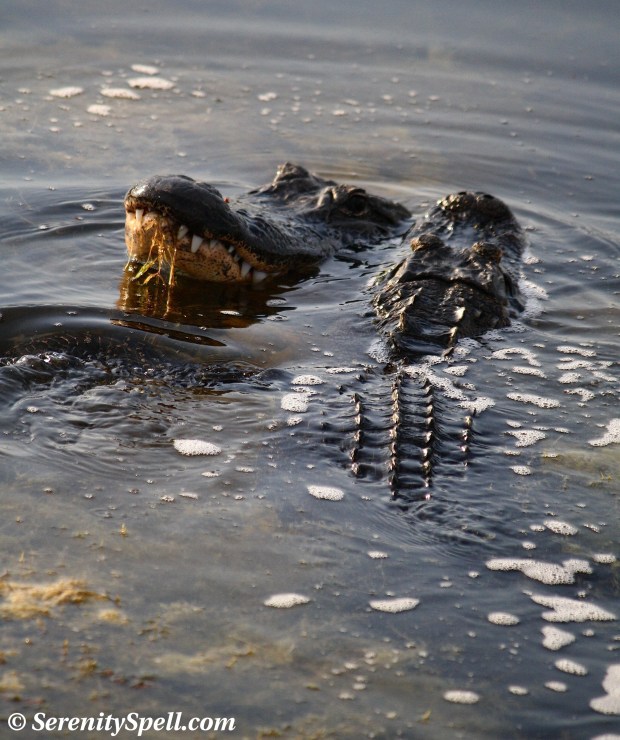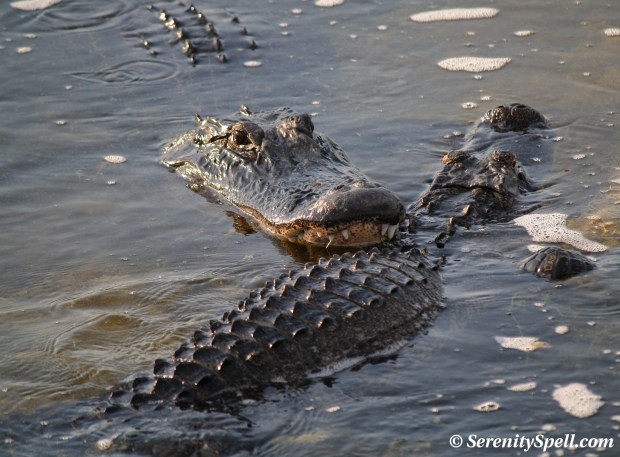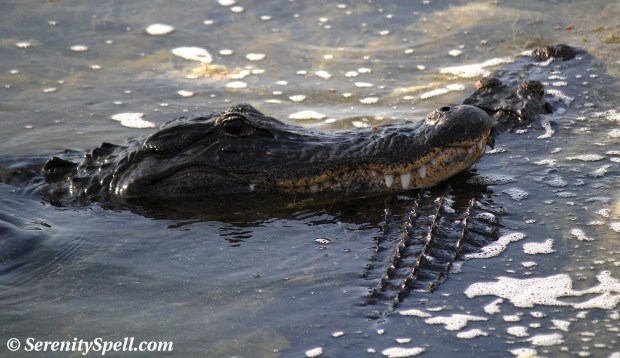Alligator Love: A Courtship
Twenty million years as a resident of planet Earth, and counting…. Scientists believe that the American alligator resembles animals that inhabited our planet as long as 100-150 million years ago — and that they may be linked to creatures dating 50-65 million years ago, managing to avoid the extinction that killed off the dinosaurs, their prehistoric contemporaries.
I was *exceptionally* fortunate to have recently witnessed a mating pair of alligators in our protected wetlands — while I believe the actual mating had already occurred (as evidenced by their babies on the nearby bank), their affinity for each other was obvious. I was thrilled to have captured the courtship images… Below!
Alligator mississippiensis
A member of the crocodilian family, there are two alligator species living in the world today: the American alligator (Alligator mississippiensis) and the Chinese alligator (Alligator sinensis). American alligators are found in the southeastern United States; the majority inhabit Florida and Louisiana, with over a million alligators in each state. Interestingly, southern Florida is the only place where both alligators and crocodiles exist side-by-side. We’ve actually seen a growing number of crocodiles in our trips to the Everglades.
Alligators live in freshwater environments, including ponds, marshes, wetlands, rivers, and swamps, as well as brackish environments. They’re long-lived animals, living more than 50 years in the wild. As with other cold-blooded reptiles, it’s common to see them basking in the sun, thus regulating their body temperatures. Occasionally they keep their mouths open, akin to a dog panting — it’s a cooling mechanism.
Nearly Extinct
Sadly, American alligator populations suffered tremendously throughout the 20th century, when they were hunted to near-extinction for their hides — an estimated 10 million alligators were slaughtered. Since the Endangered Species Act of 1973 however, these amazing creatures’ populations continue to grow, and illegal poaching is better controlled. Twenty million years on planet Earth, and we nearly managed to wipe them out for handbags.
Courtship and Breeding
Alligators reach breeding maturity at 6-10 years of age, when they’re approximately 6-7 feet long. Growth slows after this point, but some of the oldest males may grow upwards of 16 feet, reaching 1,200 pounds. We’ve seen some LARGE GATORS out in the ‘Glades…. And it’s pitiful to see the yahoos on reality TV wrestling (rastling?) the smaller juveniles. In the first place, WHY? Secondly, bullies much, picking on the babies?
Interestingly, recent studies have shown that up to 70 percent of alligator females remained with their partner — often for many years.
Breeding begins in the spring (mid-April through May, specifically), and you can hear their loud bellows throughout the swamps — calls used to attract mates and warn off other males. While (like all wildlife) gators don’t want to bother humans, the mating season isn’t the time to push your luck — aggression is at a higher level, and they may become more territorial (the older ones, at least). On our hikes, we’re always aware of the season. Alligator courtship is complex — vocalizations, head-slapping on the water’s surface, body posturing, snout and back rubbing, bubble blowing, and pheromone (scent) signals all play into the process.
Nesting and the Young
Alligator nests (or mounds) are built by the female, and comprised of vegetation, sticks, and mud located in a sheltered spot in or near the water. She lays 20-50 eggs, and covers them under more vegetation which heats as it decays, serving to incubate the eggs. The female will remain near the nest throughout the 65-day incubation period, protecting it. If a mother alligator is killed or removed, she can’t protect her nest or young — and the hatchlings are doomed. *Leave wildlife alone.*
Hatchlings are 6-8 inches long, and are near-replicas of their parents, save for a series of yellow and black stripes which camouflage beautifully with the surrounding marsh roots. For five months, they’ll remain with the mother before finding their own ways. In our area, we typically see 5-10 baby alligators survive in the protected wetlands. Perhaps less. Common predators that prey upon the juvenile alligators include snapping turtles, snakes, raccoons, bobcats, raptors, and even larger alligators. But when we find them? Oh my…. I must break up these posts, though — there are too many images, and the adorableness level is simply too high. Next: Alligator Babies!















how cool to see that! when we visited Florida a couple years ago we saw an alligator close by. a little scary for us, but the people fishing nearby didn’t seem to mind. 🙂
It really was amazing… As often as we see/encounter them (DAILY?), I’ve never witnessed this. At first, I thought I was in for a fight — you never see 2 gators in the same area! Then I realized one’s the papa and one’s the mama of the babies! 🙂 Definitely, they’re wildlife that FL natives are accustomed to — HIGHLY RESPECTFUL of (if they’re smart), but accustomed to.
I really enjoyed this, as it gave me a better insight into a species that I wouldn’t have usually researched, (mostly because I am extremely fearful of them). So thank you 🙂
Ah, how wonderful!! I’m thrilled you got to learn a bit about ’em. Alligators really are amazing creatures, just for the sake of their sheer perseverance on this planet. They’re awesome animals to see in the wild — one simply must be respectful of their predatory selves (just like if we were surrounded by bears). They really don’t want to bother us….
(I just realised the almost irony that I am wearing an alligator/croc style suit) 😀
Hahahahah!!! That’s great. Synchronicity across the pond. 🙂
amazing alligators images, very interesting info on them, wonderful post. thank you kindly for following my blog.. ; )
Thanks so very much, I’m glad you enjoyed! 🙂
Loving your post – thanks for sharing – ha! Happy Monday!
Heh, thanks so much!!! 🙂 It was a better scene than what I first expected… A fight! Happy Monday!
Fascinating, and amazing pictures. Wouldn’t have expected this behavior from alligators, at all. Thanks for the enlightenment!
You’re so welcome! I’m thrilled that you found it as fascinating as I did, when I witnessed the entire event. As often as we see these guys (DAILY!), this is the first such encounter. So exciting!!
Beautiful, primeval images. I cannot wait to see the baby pics, i know how cute they are. Glad to read that the population is high but I still cannot stomach that reality show where they trap them in snares and then shoot them. Too much enjoyment in the killing. Hopefully, they are managing this “resource” in a sensible way. Lastly, I need a faster computer so I can enjoy your posts.
I’m so happy you enjoyed them!! I’ll be posting the babies tomorrow (after I get some *work* done today, heh!). EXACTLY to your point on those shows… They treat them as hostile monsters, and I’ve glimpsed two scenes (all I could personally stomach), in which they were wrangling seriously YOUNG gators. Bullies enjoy acting tough with something they can handle, I guess — and making them into something they’re NOT. I’d love to see them with the older guys, though. 🙂